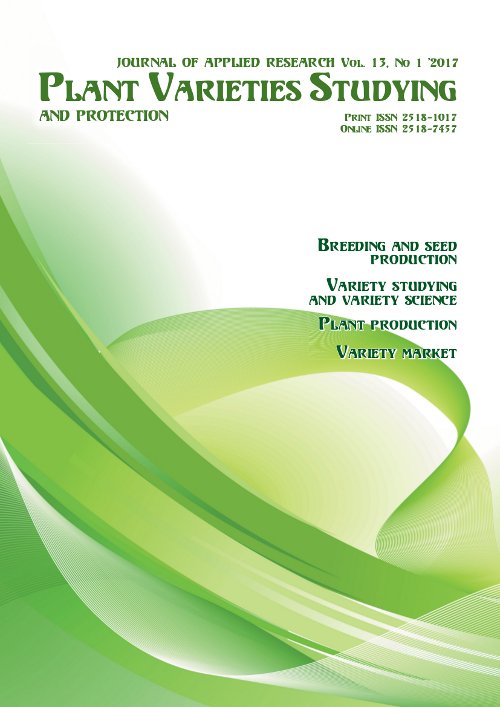Consumptive qualities of different potato varieties
DOI:
https://doi.org/10.21498/2518-1017.13.1.2017.97382Keywords:
potato, varieties, biochemical content of tubers, food quality, categories of consumptive useAbstract
Purpose. To summarize results of studying consumptive qualities of different varieties of potato and define basic characteristics which allow to subsume them under specific economic categories.
Methods. Field study, laboratory test, summarizing, analytical approach.
Results. Potato varieties entered in the State register of plant varieties suitable to dissemination in Ukraine and new ones especially to be bred at the Institute of Potato Growing of NAAS were studied during the period of 2005–2016 for such basic economic characters as consumptive quality of tubers, content of starch, dry matters, protein, sugar, vitamins, carotenoids and mineral substances as well as aminoacids, color of flesh, suitability for industrial manufacturing of potato products and for purpose of technology. Attention was paid to the good prospects to use varieties with purple, blue and red potato tuber flesh with high antioxidant capacity. Potato varieties with above characteristics and their complex combination were defined and described. The requirements of processing industry for potato as a raw material for manufacturing of potato food were given.
Conclusions. The major criterion for consumptive qualities of a potato variety and correspondingly division for the commercial use is consumptive quality of tubers, especially content of essential nutrients and their favorable combination, improved taste and cooking quality, high antioxidant capacity, suitability for potato products manufacturing and use for purpose of technology. Potato varieties can be divided for economic purposes into edible, suitable for potato products manufacturing, technical and multipurpose ones.
Downloads
References
Kuchko, A. A., Kutsenko, V. S., Osypchuk, A. A., & Batiuh, V. H. (Eds.). (1991). Dovidnyk kartopliara [Potato Grower Manual] (pp. 10–19). Kyiv: Ukrainа. [in Ukrainian]
Vlasyuk, P. A., Vlasenko, N. E., & Mitsko, V. N. (1979). Khimicheskiy sostav kartofelya i puti uluchsheniya ego kachestva [Chemical composition of potato and ways to improve its quality]. Kiev: Naukova dumka. [in Ukrainian]
Al'smik, P. I., Ambrosov A. L., Vecher, A. S., Goncharik, M. N., & Mokronosov, A. T. (1979). Fiziologiya kartofelya [Physiology of potatoes]. B. A. Rubin (Ed.). Moscow: Kolos. [in Russian]
Kuchko A. A., Vlasenko, M. Yu., & Mytsko, V. M. (1998). Fiziolohiia ta biokhimiia kartopli [Physiology and biochemistry of potatoes]. Kyiv: Dovira. [in Ukrainian]
Kozhushko, N. S., & Honcharov, M. D. (2012). Potato varieties breeding for quality. Visnik Sums’kogo nacional’nogo agrarnogo unìversitetu. Agronomiâ i biologiâ [Bulletin of Sumy National Agrarian University. Agronomy and Biology], 9, 140–145. [in Ukrainian]
Goncharov, N. D., Kozhushko, N. S., & Kravchenko, I. V. (1980). On assessment of suitability of potato varieties and seedlings for industrial processing. Nauchnye trudy NIIKKh [Proceedings of the Research Institute of Potato Farming], 37, 58–64. [in Russian]
Kononuchenko, V. V., & Molotskyi, M. Ya. (Eds.). (2002). Kartoplia: entsyklopedychnyi dovidnyk [Potatoes: encyclo pedic guide]. (Vol. 1). Bila Tserkva: N.p. [in Ukrainian]
Kozhushko, N. S., & Honcharov, M. D. (2000). Technological evaluation of potato suitability for industrial processing. Kartopliarstvo [Potato Growing], 30, 51–60. [in Ukrainian]
Kiru, S. D. (2008). Genetic resources of potato for new breeding directions. In Kartofelevodstvo: rezul'taty issledovaniy, innovatsii, prakticheskiy opyt: materialy nauchno-prakticheskoj konferencii i koordinacionnogo soveshchaniya "Nauchnoe obespechenie i innovatsionnoe razvitie kartofe levodstva" [Potato Growing: research results, innovations, practical experience: materials of scientific-practical conference and coordination meeting "Scientific support and innovation development of potato growing"] (Vol. 1, pp. 49–56). August 6–7, 2008, Moscow, Russia. [in Russian]
Bondarchuk, A. A., Mytsko, V. M., & Vermenko, Yu. Ya., (2006). Customer productivity of potato varieties under the conditions of Polissia zone of Ukraine. Visnyk silskohospodarskoi nauky [Bulletin of Agricultural Science], 6, 28–30. [in Ukrainian]
Metodychni rekomendatsii shchodo provedennia doslidzhen z kartopleiu [Guidelines for conducting investigation of potatoes]. (2002). Nemishaieve: N.p. [in Ukrainian]
Koltunov, V. A., & Voitseshyna, N. I. (2006). Suitability of potato varieties for manufacturing potato products depending on conditions, storage time and preparation for processing. Kartopliarstvo [Potato Growing], 34–35, 29–38. [in Ukrainian]
Sidakova, O. V. (2008). Evaluation of new potato varieties for biochemistry value of quality. Kartopliarstvo Ukrainy [Potato Growing in Ukraine], 1–2, 7–8. [in Ukrainian]
Sidakova, O. V. (2012). Biochemical characteristics of new potato varieties. Kartopliarstvo [Potato Growing], 41, 24–28. [in Ukrainian]
Vermenko, Yu. Ya., & Bondarchuk, A. A. (2010). Basic components of consumer value of potato. Kartopliarstvo [Potato Growing], 39, 85–103. [in Ukrainian]
Putz, B. (1990). Kartoffeln: Züchtung – Anbau – Verwertung. Hamburg: Behr's Verlag.
Putz, B., & Erste, P. (1997). C-Tupen bei Kartoffeln aus deutscher Züchtung. Kartoffelbau, 48, 280–282.
Downloads
Published
How to Cite
Issue
Section
License
Copyright (c) 2017 Ukrainian Institute for Plant Variety Examination

This work is licensed under a Creative Commons Attribution-ShareAlike 4.0 International License.
Starting in 2022, the copyright to the publication remains with the authors
Our journal abides by the CREATIVE COMMONS copyright rights and permissions for open access journals.
Authors, who are published in this journal, agree to the following conditions:
- The authors reserve the right to authorship of the work and pass the first publication right of this work to the journal under the terms of a Creative Commons Attribution License, which allows others to freely distribute the published research with the obligatory reference to the authors of the original work and the first publication of the work in this journal.
- The authors have the right to conclude separate supplement agreements that relate to non-exclusive work distribution in the form in which it has been published by the journal (for example, to upload the work to the online storage of the journal or publish it as part of a monograph), provided that the reference to the first publication of the work in this journal is included.

























 Ukrainian Institute for Plant Varieties Examination
Ukrainian Institute for Plant Varieties Examination  Селекційно-генетичний інститут
Селекційно-генетичний інститут Institute of Plant Physiology and Genetics of the National Academy of Sciences of Ukraine
Institute of Plant Physiology and Genetics of the National Academy of Sciences of Ukraine
 The National Academy of Agrarian Sciences of Ukraine
The National Academy of Agrarian Sciences of Ukraine